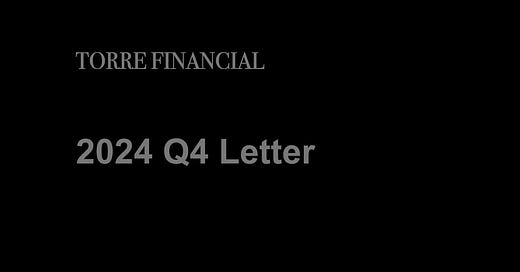2024 Q4 Letter
Review of quarterly results, contributors and detractors, portfolio overview, and personal reflection
Torre Financial consolidated accounts increased 19.3% for the year. The S&P 500 (SPY) increased 24.9% over the same period.
SPY is an ETF tracking the S&P 500, an index of 500 companies. Torre Financial invests in 25-30 high quality companies. Returns for individual accounts may vary as each account is managed separately.
The recession that many expected never came.
2024 turned out to be another great year in the markets.
Strong employment, lower interest rates, the promise of AI, and an incoming pro-business administration propelled a risk on sentiment. Bitcoin doubled. Nvidia, which accounts for 6% of the S&P 500 index, was up 171%. The Magnificent 7 climbed 64%. The outperformance of these large companies makes for difficult comps.
While we are not happy about underperforming the index, we are pleased with a nearly 20% gain for the year. This comes on top of our 51% gain in 2023.
Markets, however, do not go up forever.
As we look forward to 2025, we are focusing on protecting our capital as we stay invested in high-quality compounders. Our portfolio is well set up to outperform in a weaker market.
Top Performers and Detractors
The following companies were the top performers in 2024:
Meta (META) +66%
ServiceNow (NOW) +50%
Amazon (AMZN) +44%
Booking (BKNG) +41%
PayPal (PYPL) +39%
Big tech, including our holdings Amazon, Meta and ServiceNow, benefitted from the rise of AI. Booking has been a steady performer, continuing to gain share as travel returned post-pandemic. PayPal was the turnaround story of 2024. Although shares are still down from the peak, the new CEO has instilled new energy into the company and delivered more and more evidence to add credibility.
The following companies were detractors to our performance in 2024:
Adobe (ADBE) -25%
Workday (WDAY) -6%
Edwards Lifesciences (EW) -3%
UnitedHealth Group (UNH) -2%
Thermo Fisher Scientific (TMO) -2%
Adobe’s proposed acquisition of Figma was shut down by regulators, reigniting worries that upcoming competitors can challenge their moat. Adobe has also been investing heavily in AI. The company is happy to take a long term approach, while investors are looking for near term monetization to validate the investment.
Workday projected a slight slowdown in revenue as they balance profitability and growth. On the flip side, Workday was added to the S&P 500 in December – a significant achievement.
Healthcare struggled this year. We initiated or added to Edwards, UnitedHealth, and Thermo Fisher this year. These are exceptional companies. Healthcare demand is resilient to the economy, providing diversification and stability.
Portfolio Overview
We are confident that our portfolio will do well in any market environment. We have some of the strongest businesses across various proven industries and business models.
Our portfolio is well diversified across technology, healthcare, risk management, payments, e-commerce, travel, advertisements, and enterprise efficiency. Each of these are supported by compelling longer-term investment themes.
In big tech, we have Google, Meta, and Amazon. These companies continue to innovate and deliver amazing offerings, whether in their core business or upstart businesses including cloud and AI.
In healthcare, we’ve built up positions in Abbott, United Health, Danaher, Edwards Lifesciences, and Thermo Fisher Scientific. Healthcare adds resilience and stability, without sacrificing growth. Demand is increasing as the population continues to age.
In risk management, we have Intercontinental Exchange, FactSet Research, Moody’s and S&P Global. These companies help their customers make better informed decisions. As market volatility increases, the value of these products increases, making them great antifragile components of our portfolio.
Enterprise efficiency includes Salesforce, Workday, ServiceNow, Adobe, Intuit, and ADP. These companies make it easier and cheaper for other companies to operate. As wages rise over time, their value proposition only strengthens.
Our payments companies include Mastercard, Visa, and PayPal. The secular shift to digital transactions is still underway and has a lot of room to run. Because these companies take a slice of the transaction, they benefit from inflation as the gross merchandise volume increases.
In travel, we have two global leaders, Booking and Airbnb. Humans have an innate desire to travel. Experiences make for a rich life. Travel will benefit as middle classes grow across the world. Prices will go up over time (land, housing, wages), benefitting the marketplace business model of both Booking and Airbnb.
All of our companies exhibit high returns on capital, competitive advantages, and durable growth.
Throughout the year, we exited many of our high growth software positions, including The Trade Desk, CrowdStrike, Zscaler, Cloudflare, and Datadog. While we believe these can be all exceptional companies, the risk to our portfolio is too significant on both valuation and volatility. We discussed this transition more in depth in our 2024 Q3 Letter.
When compared to the S&P 500, our portfolio:
has slightly lower revenue growth and slightly less ROIC
is more efficient in their use of capital on a FCF basis
has superior margins across the board
uses less leverage
is much cheaper on a FCF yield basis
Our portfolio’s free cash flow (FCF) yield of 3.9% is significantly above the index’s 2.7%. Our portfolio is much cheaper than the index, for comparable or better performance.
When looking at the trends, our valuation improved over Q4 (from 3.7% to 3.9%) while the index got more expensive (from 2.9% to 2.7%). This is one example of how we intend to protect capital while staying invested.
Whether it comes in 2025 or beyond, we expect volatility. Markets will go up and down. That is the price of admission. Our companies are more likely to come out stronger from any period of volatility, giving us confidence that our portfolio will come out ahead.
Portfolio Management
Diving into the details on the portfolio and target allocation weights:
Keep reading with a 7-day free trial
Subscribe to Torre Financial Newsletter to keep reading this post and get 7 days of free access to the full post archives.






